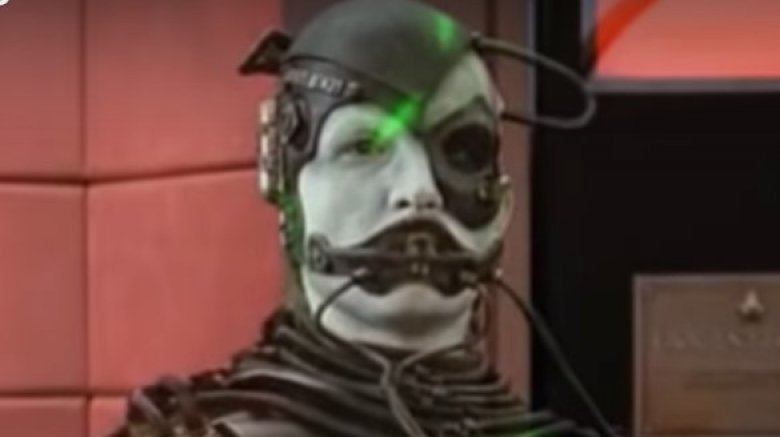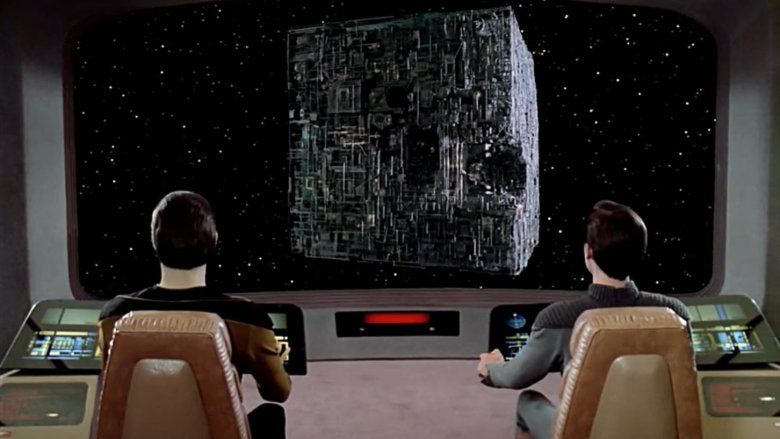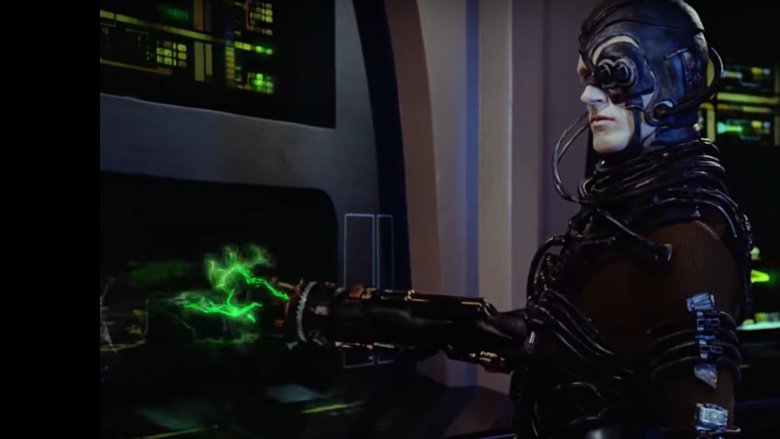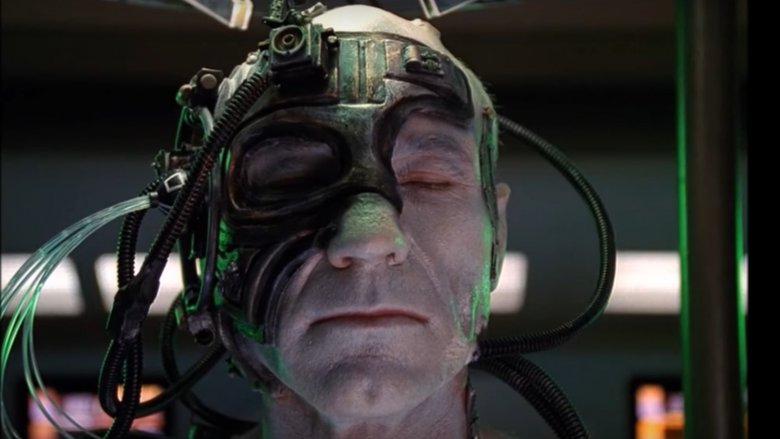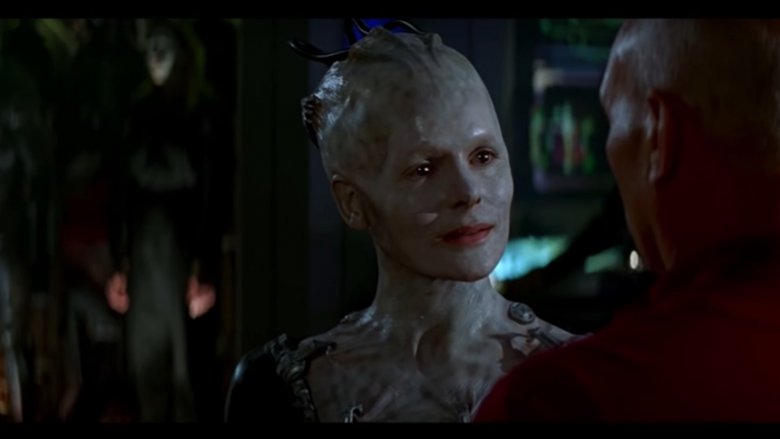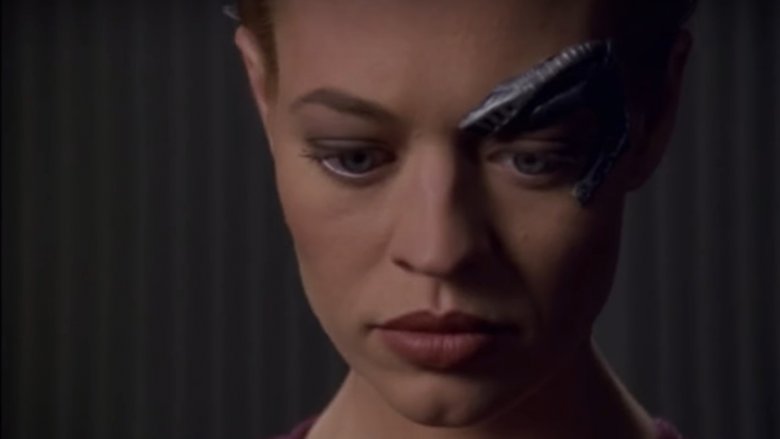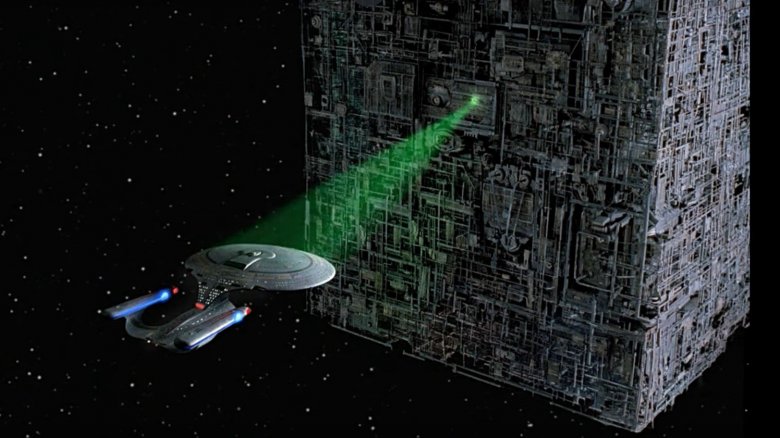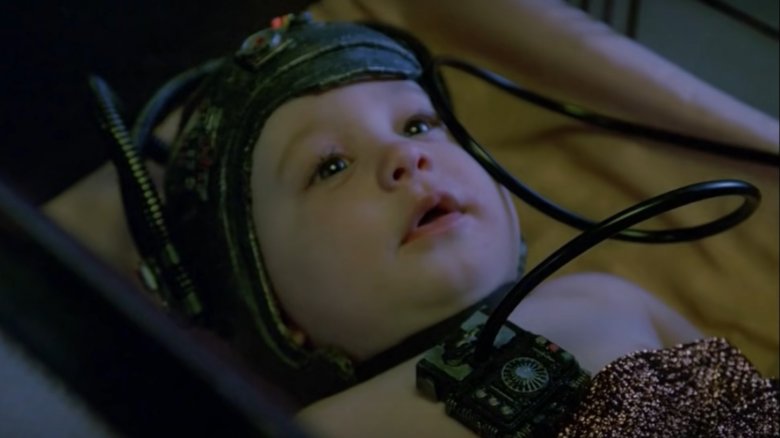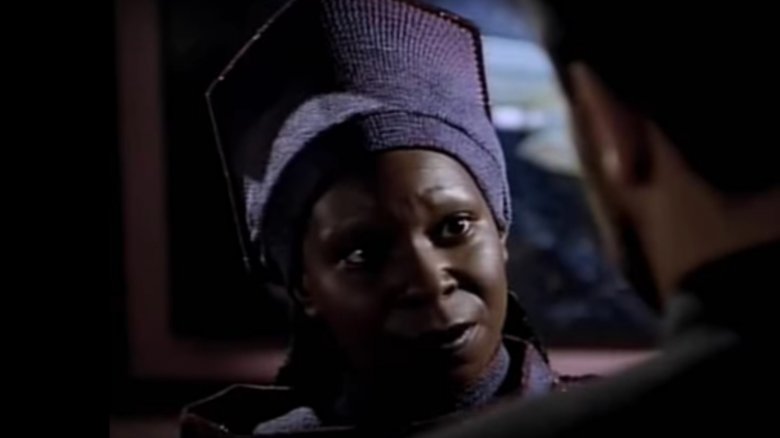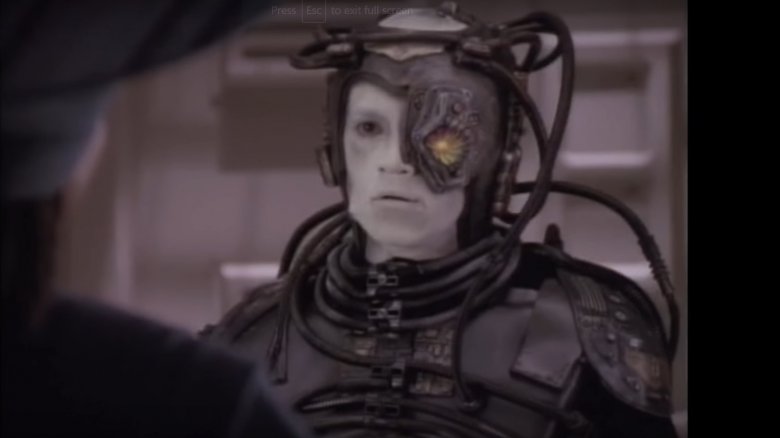The Messed Up Truth About The Borg
The Borg, the pasty-faced, animatronic collective body of terror first introduced to Star Trek fans in The Next Generation, are the stuff of nightmares. Relentless in their pursuit of power and perfection, they zip around the United Federation of Planets and the Alpha and Delta Quadrants in their cube- and sphere-shaped vessels, assimilating everything and everyone in their path. As they famously state in Star Trek: First Contact, resistance is futile. Once the Borg find you, they will stop at nothing to steal your individualism and incorporate your greatest strengths into their shared consciousness.
According to the Trekspertise episode, "The History of the Borg," by the time the Borg meet the members of Captain Picard's Enterprise in the 2370s, they've successfully assimilated more than 10,000 species, and have set their ocular implants on earth.
So far, so scary, but, like everything in the Star Trek universe, the Borg are complex and not nearly as black and white as they appear. In fact, the rigid set of rules that seems to govern their communal society proves to be both flexible and strange. That's not to say you'd want a Borg cube for your neutral zone neighbor, though. Read on for some of the more messed up and downright weird aspects of these badass villains.
The Borg are assimilation snobs
The Borg enter the Star Trek canon thanks to the irrepressible character of Q, who, on a whim, flings the Enterprise across the universe into Borg territory in the second season of Next Generation. Soon, Captain Picard and company find themselves face-to-face with a Borg cube. Picard tries at first to make peace. Then, when it grows increasingly clear that the Borg are not that kind of collective — they catch the Enterprise in a tractor beam and slice off the saucer section, killing 18 crew — Picard attempts to destroy their ship. Again, no dice.
Deciding that they need a new strategy, Commander William Riker takes a small away team to visit the Borg on their home turf. Given what Q has told the Enterprise about the Borg, one might expect the drones — Borg temporarily disconnected from the collective — to go into attack mode immediately when they spot the Starfleet officers aboard their ship. Instead, Riker, Worf, and Data are largely ignored, left to explore the cube without being hassled. Why? Because the Borg are busy repairing their ship, and can't be bothered to assimilate any of these tasty Starfleet Officers. Clearly, they don't think these guys cut it, and aren't worth the three extra seconds of not fixing their ride it would take to assimilate them.
Ouch. Sorry, Riker. Klingon apologies, Worf. Not only are they a frightening presence from Day One, they're also kind of a bunch of snobs.
Resistance to the Borg is futile (or is it?)
In the Next Gen film, First Contact, the Borg treat the crew of the Enterprise to this warm and fuzzy greeting: "Lower your shields and surrender your ships. We will add your biological and technological distinctiveness to our own. Your culture will adapt to service us. Resistance is futile." And it would seem, considering the Borg's considerable powers, that no individual or civilization would be able to put up a fight against such an intimidating enemy.
Of course, loyal Trekkers know that several life forms and groups do mount a successful resistance to the Borg, the first being Captain Picard, who having been assimilated in the Next Gen episode "The Best of Both Worlds," is restored to himself after a mind-meld with Data. And then there are the Undine, or species number 8472, an enemy even more menacing and cruel than the Borg whose biological secrets the Voyager's Captain Janeway attempts to trade with the Borg in return for safe passage through Collective air space. The Borg and the Undine wage a violent war that ensnares the Voyager crew, making it so that Janeway, Seven of Nine, and the Voyager's hologram doctor have to go to rather spectacular lengths — including making use of so-called "neurolytic pathogens" — to emerge from the Borg's clutches relatively unscathed.
So, resistance to the Borg isn't necessarily futile. It's just really difficult and requires a lot of literary gymnastics on the part of the writers.
Watch out for those tricky Borg nanoprobes
Adherents of Star Trek: The Next Generation might think that there's only one way to go Borg: through a surgical procedure. That, after all, is how Captain Picard is turned into Locutus in "The Best of Both Worlds." But there's an even grosser way to be assimilated: with a transfusion of nanoprobes delivered by, you guessed it, the tubules in a drone's hand. What better way for a grayscale, parasitic race to bring you into the fold than by filling your bloodstream with minuscule computers that quickly replace your very self with a throbbing desire to be a part of a perfect collective?
According to the official Star Trek database, when one is injected with nanoprobes, a lifeform's skin begins to turn gray within seconds. This was the fate of Seven of Nine, a Borg-in-recovery who joins the crew of Star Trek: Voyager during the two-part episode, "Scorpion." Formerly known as Annika Hansen, Seven of Nine's whole family was assimilated by the Borg while helming the USS Raven.
Incidentally, nanoprobes are actually a thing IRL. They're optical devices used in semiconductors and in stem-cell therapy. Star Trek, putting the "fiction" in "science" since star date 2265.
Yas Borg Queen
Individual Borg are called drones and the collective consciousness is often referred to as "the hive mine," and so in a way it should have come as no surprise to Trekkies — ahem, Trekkers — when a Borg queen made her rather lime green and buzzworthy entrance in Star Trek: First Contact. But still, it does surprise because there's no hint in any of the Borg Next Gen episodes that the race has any sort of hierarchical structure.
According to this Chicago Tribune profile of Alice Krige, who played the Borg Queen in First Contact, it took makeup artists six hours to transform the 42-year-old actress into the head of the hive. After that, she was ready and raring to try to tempt Data and Captain Picard with her Borg-ish feminine wiles. The Borg queen is a thirsty girl, and a dangerous force in the universe. That is — spoiler alert — until she isn't. Krige's appearance started a trend. A number of Borg Queens appear in Star Trek: Voyager, all of them played by Susanna Thompson. In keeping with the guiding principles of the Borg, each queen is identical to the one who came before.
And while die-hard devotees of the Star Trek canon would like to find a rational justification for the Borg's having a queen at the helm, she was reportedly dreamed up by writers worried a collective villain would not be compelling enough to carry a feature film.
Borgs Anonymous
The Borg spend a lot of their time plugged into the collective. Literally. As the "Q Who" episode explains, drones are allotted their own closet-sized cell in which to commune with the race's shared consciousness. They unplug only to wage war and steal the secrets and strengths of other races and civilizations. Hey, it's a living.
So what happens when an individual drone gets cut off from the collective and disconnected from the hive mind? In the case of Star Trek: Voyager's Seven of Nine, she gradually begins to reconnect with her human self, who, prior to being assimilated, was Annika Hansen, daughter to scientists Magnus and Erin Hansen who made the study of the Borg their life's work until, well, you know, the Borg decided they were worthy of plug-in closets of their own.
Played by Jeri Ryan, Seven of Nine goes through her own transformation over the course of Voyager's last four seasons, evolving from a robot-in-a-skin suit allergic to emotion and unaware of the little pleasures in life to an almost fully-fledged human woman who enjoys a good meal and dons a red dress if she feels like it. Of course, she never goes anywhere without her glittery ocular implant, but every race has its idiosyncrasies. Just look at the Ferengi and their hair curtains. And the Benzite and their mouth steam trays. Sometimes a girl just has to accessorize.
Which came first? The collective or the drone?
How did the Borg come to be exactly? The short answer is, no one's really sure. The beginnings of the Borg are a bit of a mystery. We know, thanks to articles like this one in Vulture, that their first interactions with other civilizations began sometime in the 1400s on a remote planet in the Delta Quadrant. And this nerdalicious history of the Borg even does the math for us, illustrating that the Borg had assimilated 262 cultures by 2145 and then, having hit the gas on the whole take-over thing, managed to bring 10,026 cultures into its hive mind by the 2370s. According to Heavy, the Borg began as a weak human-like species, gaining in strength and power with each new assimilated race. But were they born of a mother-type figure? Or pieced together product by a mad scientist's experimenting with brain caps and go-go-gadget phaser arms?
Because Star Trek is now a franchise with seven shows and twelve movies in its oeuvre, not to mention countless novel spinoffs, comic books, and fan fic threads, it's no wonder that even the closest followers of the canon can grow confused, trying to piece together a coherent origin story of the Borg. Just remember this: resistance is futile, except when isn't. Borg drones have no relationship with their individual, pre-Borg natures, except when they do. And 'Borg' spelled backwards is 'Gorb.' You're welcome.
Like Rumspringa for drones
Perhaps you've heard of the Amish rite-of-passage "Rumspringa," a period of time in which Amish adolescents are allowed to wear pants with zippers on them and party. A lot. Well, the Borg, perhaps because they, too, are a buttoned-down race, not to mention strange and inconsistent AF, likewise have a space for their drones to go when they need to get in touch with their wild sides. This place is called Unimatrix Zero, and, in a two-part cliffhanger Voyager episode of the same name, Star Trek fans get an intimate look at drones in their not-so-natural habitat.
Like the holodeck, Unimatrix Zero is a virtual reality wonderland, and when Seven of Nine is pulled there by a group of drones going through their regeneration cycles, she has the chance to reunite with a former lover in an idyllic, forest-like setting, complete with children — actual Borg children! — and mountains and pristine lakes. Of course, the Borg queen is none too pleased by these developments. What, no plug-in brain closets? No nanoprobe tubules? No way. Insult to injury, the very existence of Unimatrix Zero is weakening the collective bond of the Borg, and so the queen, backed by reinforcements, goes about systematically subduing the rebels, i.e. slaughtering them wholesale.
It's Star Trek, though, so where there's a will for freedom, there's a way. Too bad for the Borg it comes in the form of a civil war.
To the Borg, Aerodynamics are Futile
The Borg's ships-of-choice are the cube and the sphere, both of which are, for reasons that are hard to explain, uniquely spooky in a universe full of spooky ships. (See Klingon Birds of Prey, the spaceship equivalents of Teenage Mutant Ninja Turtles, and the Romulan Narada driven from 2009's Star Trek film, which looked like a bike helmet designed for a Velociraptor. And don't even get us started on the phallic whale probe from The Voyage Home.)
Anyway, let's start with the cube. According to Syfy Wire, each Borg cube side measures three kilometers across, giving it a total volume of 27 cubic kilometers. Anywhere from five thousand to roughly 180,000 drones can fit inside. And these rides are pimped. They're outfitted with ablative hull armor, power disruptor beams, high-yield torpedoes, and transwarp drives that allow them to access the far reaches of space in a matter of moments. Eat that, Tesla.
And now to the sphere, which is typically used as auxiliary or long-range tactical crafts. These cavernous scout ships can hold up to 11,000 drones, not to mention an entire Starfleet vessel, inside their shield-protected walls. The Borg sphere got its first shout out (both in our timeline and Star Trek's timeline) in First Contact, where part of a hull is discovered by a scientific exploratory team. Unfortunately for the scientists, a few drones survive the crash, hungry for fresh Starfleet scientist brain power. RIP.
What a pretty Borg nursery! Let me guess -- Pinterest?
One of the creepiest moments in all of Star Trek just might be when Commander William Riker and his away team stumble upon a Borg nursery full of black-capped infants in the "Q Who" episode of The Next Generation. It would appear from this show that the bulk of the Borg begin as human or human-like babies and then gradually morph into robotic drones. But, given that they maintain their species by assimilating other cultures, does it really make sense that they would begin as bouncing baby Borg?
In Voyager, the record gets corrected. Seven of Nine, having been assimilated in 2356, along with her exobiologist parents, claims the Borg don't have nurseries per se. Rather, their young are kept in maturation chambers until they're fully-fledged adult drones. And, for the trivia geeks out there, the gestation period for a Borg drone is seventeen cycles. Take that to your next Class M planet cocktail party.
Guinan called it
In the Star Trek: The Next Generation episode "Q Who," when the Borg are first introduced to the Trekkerverse, Guinan (played by Whoopi Goldberg) warns Captain Picard not to mess with the Borg. They killed her people, she tells him. They're not on same level as the Romulans or Ferengi or Klingons. The Borg are a whole new ballgame, she says. A race apart.
But, as so often happens when a female — an El-Aurian, in this case — speaks truth to power, her warnings fall on deaf ears. Picard tries to reason with the Borg. Then he attempts to defeat them. When neither approach proves fruitful and Picard loses 18 members of his crew, not to mention a hefty section of the ship to the Borg's assimilation tractor beam, he decides to send Riker, Data, and Worf to the Cube to confront the Borg, face-to-face, eye-to-ocular implant.
Again, Guinan does her best to counsel the ship's leadership to reconsider. She tells Riker that no good can come of confronting the Borg, but he, Data, and Worf beam down to the cube anyway and, while they're there, they see that Guinan was right. The Borg are, indeed, a different kind of villain and one they'll be forced to reckon with again when, in "The Best of Both Worlds," they almost lose their beloved Picard to the collective.
Much Ado About Hugh
It's a running joke among Next Gen fans that if you're unfortunate enough to land in Dr. Beverly Crusher's sick bay, chances are good you'll be red-shirted before the credits roll. But, in the episode "I Borg," Dr. Crusher does succeed in saving a patient, Hugh the Borg drone.
Hugh is rescued by the crew of the Enterprise after his scout ship crashes in the Algoris Cluster. Picard, having had his own traumatic brushes with the Borg in earlier episodes, would like nothing more than to keep Hugh, the Borg formerly known as Third of Five, in the brig, but Crusher insists he be treated like any other sick patient, and she slowly nurses him back to health. The rest of the crew embrace Hugh as well, helping him cope with life outside the collective. He begins to develop an individual mindset, succeeding in convincing even Captain Picard that Borg can be rehabilitated. Hugh eventually returns to his cube, a changed Borg.
Later in the series, Hugh's cube falls into disarray, so much so that Lore, Data's black sheep brother, is able to take over the ship. Hugh eventually triumphs over Lore in part because of his ability to disconnect from the collective and think on his own. As Star Trek's first sympathetic portrayal of a Borg drone, Hugh sets the stage for Seven of Nine, as well as a deeper understanding of what it means to be human. And a Borg. And a creature stuck somewhere in between.
